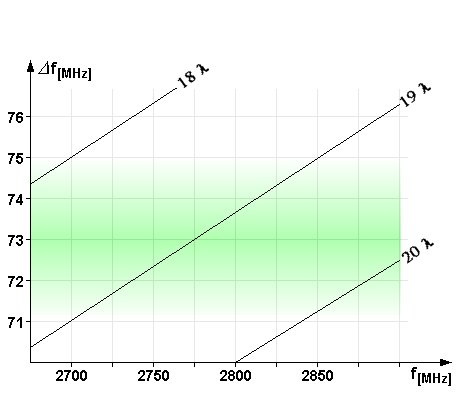Tuning the diplexer/filter

Figure 1: Frequency diagram of a given diplexer with a detour of 19 times the wavelength in the E-Band
The example given here is for the air traffic control radar AN/TPN-24. A waveguide diplexer is most effective when the tunable detour line simultaneously meets the following conditions:
- the phase shift for the A frequency must be zero;
- the phase shift for the B frequency must be 180 degrees.
The values in the diagram are mathematically given by the fact that the same waveguide length must have an even integer multiple of half the wavelength for one frequency and an odd integer multiple of half the wavelength for the second frequency:
| fB = fA· (1 + | 1 | ) | where |
fA = Frequency of the 1st transmitter fB = Frequency of the 2nd transmitter kv = Factor of the integer multiple of the wavelength in the waveguide |
(1) |
| 2·kv |
The frequency spacing is thus given constructively. If the radar station is nevertheless forced to a different frequency spacing, high losses in the diplexer are to be expected both on the transmit and on the receive path.
However, since the calculated frequency spacing is valid both above the A frequency for the B frequency and also below the A frequency for this diplexer, an additional waveguide filter for the frequency (2·fA-fB) is required.
Conclusion
This means that the diplexer only meets the required frequency spacing of 72 MHz if the length of the detour line is exactly 19 times the wavelength of the A transmitter and the operating frequency of the A transmitter is exactly 2 736 MHz. At all other frequencies, this diplexer is more or less ineffective at this frequency spacing.
However, since the transmitters power is measured at the directional coupler for antenna feed (i.e after the diplexer) and two or three decibels attenuation in the diplexer can be compensated by an increase in the magnetron current, this ineffectiveness is usually not noticeable. However, this attenuation also occurs on the receiving path! And if only half of the echo signal arrives at the receiver, the crew will only be surprised that the B transmitter does not achieve a range for inexplicable reasons.
This can only be remedied by assigning working frequencies that are adapted to the diplexer characteristics. This means a slightly lower frequency spacing than 72 MHz in the lower frequency band and a slightly larger frequency spacing in the upper frequency band. The manufacturer allows this and gives in the technical order a permission of tolerances of up to two megahertz. This means that if the A transmitter is tuned to 2 800 MHz, then a frequency spacing of 74 MHz is more effective than 72 MHz: the B transmitter should be tuned to 2 873.7 MHz. However, if the A transmitter operates at 2 708 MHz, then the frequency 2 779.2 MHz is most effective for the B transmitter.

Figure 1: Frequency diagram of a given diplexer with a detour of 19 times the wavelength in the E-Band
